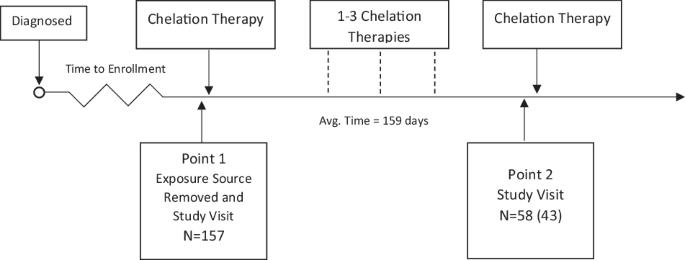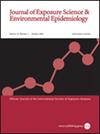螯合对铅中毒儿童骨铅储存的影响。
IF 4.7
3区 医学
Q2 ENVIRONMENTAL SCIENCES
Journal of Exposure Science and Environmental Epidemiology
Pub Date : 2024-12-03
DOI:10.1038/s41370-024-00735-1
引用次数: 0
摘要
背景:铅暴露仍然是儿童发育过程中的一个关键问题。治疗铅中毒的一种方法是螯合——这是一个有争议的话题,结果各不相同。骨铅是人体铅负荷的标志,占儿童铅储存量的60-90%。目的:在本研究中,我们旨在确定一组铅中毒儿童(血铅>25µg/dL)螯合治疗后骨铅的变化。方法:在中国上海新华医院诊断为铅中毒的儿童被招募到我们的研究中,测量了他们的骨铅水平,并接受了为期一周的静脉注射,住院治疗乙二胺四乙酸螯合治疗。在为期两年的研究中,使用相同的治疗方案和骨铅测量完成了多达三次临床访问。我们测量了通过各种潜在来源暴露的儿童铅暴露的生物标志物,包括家庭污染物、当地工业排放、传统药物或含铅炊具。结果:我们观察到螯合治疗后骨铅的显著差异(p)。意义:研究结果表明,螯合治疗对降低初始血铅水平大于25 μ g/dL的儿童骨铅储存有效。影响说明:儿童接触铅是一个持续存在的问题——严重影响整个生命周期的健康。暴露后,铅在儿童骨骼中作为潜在的内源性暴露源储存数年至数十年。我们的研究表明,螯合疗法在降低血铅水平的同时,也降低了骨铅水平。骨铅的减少将有效地减少内源性铅释放的可能性,并限制铅暴露所造成的损害。本文章由计算机程序翻译,如有差异,请以英文原文为准。

The effect of chelation on bone Pb stores in Pb poisoned children
Lead exposure remains a key problem for children during development. One treatment for lead poisoning is chelation – a topic that remains controversial with varied results. Bone lead serves as a marker of total body burden of lead and encompasses between 60-90% of lead storage in children. In this study, we aimed to identify the change in bone lead as a result of chelation therapy in a group of lead poisoned children (blood lead >25 µg/dL). Upon diagnosis with lead poisoning at Xinhua Hospital in Shanghai, China, children were recruited to our study, had their bone lead levels measured, and underwent one-week of intravenous, in-patient ethylenediaminetetraacetic acid chelation treatment. Up to three clinical visits with the same treatment protocol and bone lead measurements were completed over the two-year study. We measured biomarkers of lead exposure for children exposed via various potential sources, including home contaminants, local industrial emissions, traditional medicines, or lead cookware. We observed significant differences with bone lead after chelation therapy (p < 0.0001), even after calculating a conservative model for theoretical decay from known bone turnover (p = 0.01). The difference identified between our observed change in bone lead and literature established bone lead change significantly increased with more chelation treatments. A significant reduction in bone lead was observed following chelation treatment of children with lead poisoning – a difference that increased more with more chelation. Study results indicate that chelation treatment is effective in reducing bone lead stores in children with initial blood lead levels greater than 25 µg/dL. Lead exposure in children is a consistent problem – drastically impacting health across the life span. After exposure, lead stores in the bone of children serving as a potential endogenous source of exposure for years to decades. Our study demonstrated that chelation therapy, while reducing blood lead levels, additionally reduced bone lead levels. A reduction in bone lead would effectively reduce the potential for endogenous release of lead and restrict the damage done by lead exposure.
求助全文
通过发布文献求助,成功后即可免费获取论文全文。
去求助
来源期刊
CiteScore
8.90
自引率
6.70%
发文量
93
审稿时长
3 months
期刊介绍:
Journal of Exposure Science and Environmental Epidemiology (JESEE) aims to be the premier and authoritative source of information on advances in exposure science for professionals in a wide range of environmental and public health disciplines.
JESEE publishes original peer-reviewed research presenting significant advances in exposure science and exposure analysis, including development and application of the latest technologies for measuring exposures, and innovative computational approaches for translating novel data streams to characterize and predict exposures. The types of papers published in the research section of JESEE are original research articles, translation studies, and correspondence. Reported results should further understanding of the relationship between environmental exposure and human health, describe evaluated novel exposure science tools, or demonstrate potential of exposure science to enable decisions and actions that promote and protect human health.

 求助内容:
求助内容: 应助结果提醒方式:
应助结果提醒方式:


